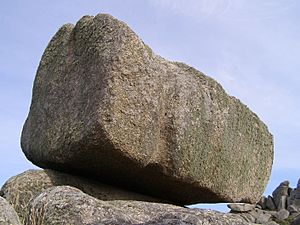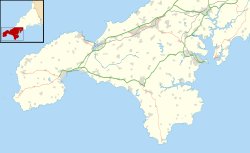Logan Rock facts for kids

Close-up of the Logan Rock near Treen
|
|
| Location | Cornwall |
|---|---|
| Coordinates | 50°02′29″N 5°38′11″W / 50.041361°N 5.636468°W |
| Type | logan or rocking stone. |
| History | |
| Material | Stone |
| Site notes | |
| Condition | Restored |
| Public access | Open |
The Logan Rock (which in Cornish is called Men Omborth, meaning balanced stone) is a famous rocking stone near the village of Treen in Cornwall, England. It's a huge rock, weighing about 80 tons! What makes it special is that it can rock back and forth. In 1824, a group of British sailors moved it to show off. But local people were upset because the rock was a popular tourist spot. So, the sailors had to put it back. Today, the Logan Rock still rocks, but not as easily as it used to. A walking path called the South West Coast Path goes right by it.
Contents
Exploring the Logan Rock's Location
The Logan Rock is a giant, ninety-ton granite boulder. It sits right on the edge of cliffs overlooking the English Channel. This spot is about one mile south of Treen village.
Treryn Dinas: An Ancient Fort
The rock is inside an ancient place called Treryn Dinas. This was an Iron Age promontory fort, also known as a cliff castle. It had five lines of defenses to protect it. The Logan Rock itself is perfectly balanced because of natural weathering (how wind and water wear down rocks). Before 1824, you could rock it with just a little push.
Surrounding Natural Wonders
The name Logan Rock also refers to the whole tip of the headland where it sits. To the east, below the rock, is a place called Cripp's Cove. You can also see several stacks (tall, thin rock formations) around the Logan Rock. These include Great Goular, Horrace, and Seghy.
Protected Natural Area
This entire area is part of the Treen Cliff Site of Special Scientific Interest (SSSI). It was marked as special in 1951 for its unique marine heathland and rare plants. It's also within the Cornwall Area of Outstanding Natural Beauty (AONB) and the Penwith Heritage Coast. The National Trust owns and looks after this beautiful spot.
Underwater Protection: Runnel Stone Marine Conservation Zone
The Runnel Stone Marine Conservation Zone was created in 2016. It covers about 7¾ square miles (20 km2) of the sea. This zone protects different underwater homes for sea creatures. These include rocky areas near the coast and soft sand on the sea floor. It helps protect animals like the pink sea fan (Eunicella verrucosa), which lives on the eastern side of the headland.
What's in a Name? The Logan Rock's Meaning
The original Cornish language name for the rock is Men Omborth. This means balanced stone. It was first written down in 1870 as Men Amber.
The Word "Logan"
The word "logan" (pronounced "logg-un") likely comes from an old English word, "log." This word means "to rock." In some parts of the UK, rocking stones are even called "logging stones." An old writer named Bray noted in 1832 that people used the phrase 'to log the child's cradle.' This shows how the word "log" was used for rocking.
Possible Norse Connection
Some people think the name for rocking stones might come from the Danish word "logre." This word means 'to wag the tail.' This idea suggests a possible Norse (Viking) origin. Vikings often raided along the British coast between 800 and 1000 AD. So, while it's just a guess, a Norse link for the word Logan is possible.
The Famous Story of the Logan Rock
The Logan Rock is one of the most famous rocking stones. Many people know its story. For example, in a poem called "Caractacus" by William Mason, the Logan Rock is described as a huge, magical stone. The poem says it moves easily for someone with a pure heart, but stays still for a traitor.
Lieutenant Goldsmith's Challenge
Another reason the Logan Rock is so famous is because of a big event in 1824. A naval officer named Lieutenant Hugh Goldsmith, who was the nephew of the poet Oliver Goldsmith, was involved. He and about ten or twelve of his crew from the ship HMS Nimble used tools to push the huge granite boulder. They wanted to prove that nothing was impossible for British sailors. They managed to make the rock fall from its perch on the cliff top. It didn't fall all the way down, but slid into a narrow crack.
This action greatly upset the local people. The Logan Rock was a big tourist attraction, bringing many visitors and money to Treen. A local leader, Sir Richard R. Vyvyan, was especially unhappy. The community demanded that the British Navy punish Lieutenant Goldsmith. They wanted him to lose his job unless he put the rock back himself.
Putting the Rock Back
However, a man named Davies Gilbert convinced the Lords of the Admiralty (the Navy's leaders) to help Lieutenant Goldsmith. The Navy sent thirteen capstans (machines for lifting heavy things) with ropes and chains from their dockyard. They also gave £25 towards the costs. Gilbert helped raise more money too.
After many months of hard work, on November 2, 1824, the Logan Rock was finally put back. Thousands of people watched. More than sixty men used the equipment to move the rock. It was returned to its "rocking condition." The total cost of this huge effort was about £130. You can even see a copy of the original receipt in The Logan Rock public house in Treen today.
After the Restoration
For a while after it was put back, the rock was kept chained. But eventually, these chains were removed. However, tourism in Treen seemed to go down after this event. Some people blamed the Logan Rock's condition for this. For a time, Treen was even nicknamed 'Goldsmith's Deserted Village'.
You can still see the anchor holes in the surrounding rocks. These holes were drilled to help pull the huge rock back into place. But it seems the rock doesn't rock as easily as it did before. A visitor in 1870, Francis Kilvert, wrote that he saw a guide rock it, and then he tried too. He said it rocked, but "very slightly." He noted it had "never rocked so well and easily since it was wilfully thrown down."
However, local historian Craig Weatherhill says that if you push rhythmically on the rock's south-western corner, you can still get it moving. Once it starts, one hand can keep it going. He also mentions another smaller rocking stone nearby, called the Lady Logan Rock. Legend says this is a giantess who was turned to stone by curses.
Images for kids








